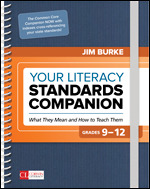Your Literacy Standards Companion, Grades 9-12
What They Mean and How to Teach Them
- Jim Burke - Burlingame High School, Burlingame, CA
Corwin Literacy
Standards-based learning just got a lot easier
In this resource, Jim Burke provides indexes for all states implementing state-specific ELA standards. This index allows you to see and understand which page number to turn to for standards-based teaching ideas.
Beyond that? It’s the same great go-to guide putting the standards into daily practice across English Language Arts, Social Studies, Science, and Technical Subjects.
It’s all here, page by page:
- Grades 9–10 standards positioned alongside 11–12 standards with key distinctions highlighted so teachers know what they must teach from grade to grade
- All the different content-area versions of the standards arranged to facilitate easy reference and schoolwide collaboration
- Explanations of each standard on corresponding pages, written in accessible language, along with prompts and questions to help students learn and apply each standard
- Essential content to cover and lesson ideas for modeling the literacy skills behind the standards
- Instructional techniques for each standard, based on Jim’s extensive teaching experience and current research on effective instruction
- A complete glossary for each standard and adaptations for ELL students
With this book, you have what you need to bring about astounding clarity of expectations for what students are to learn, and what teachers can do to bring about the sustained literacy experiences students need to apply their learning.

